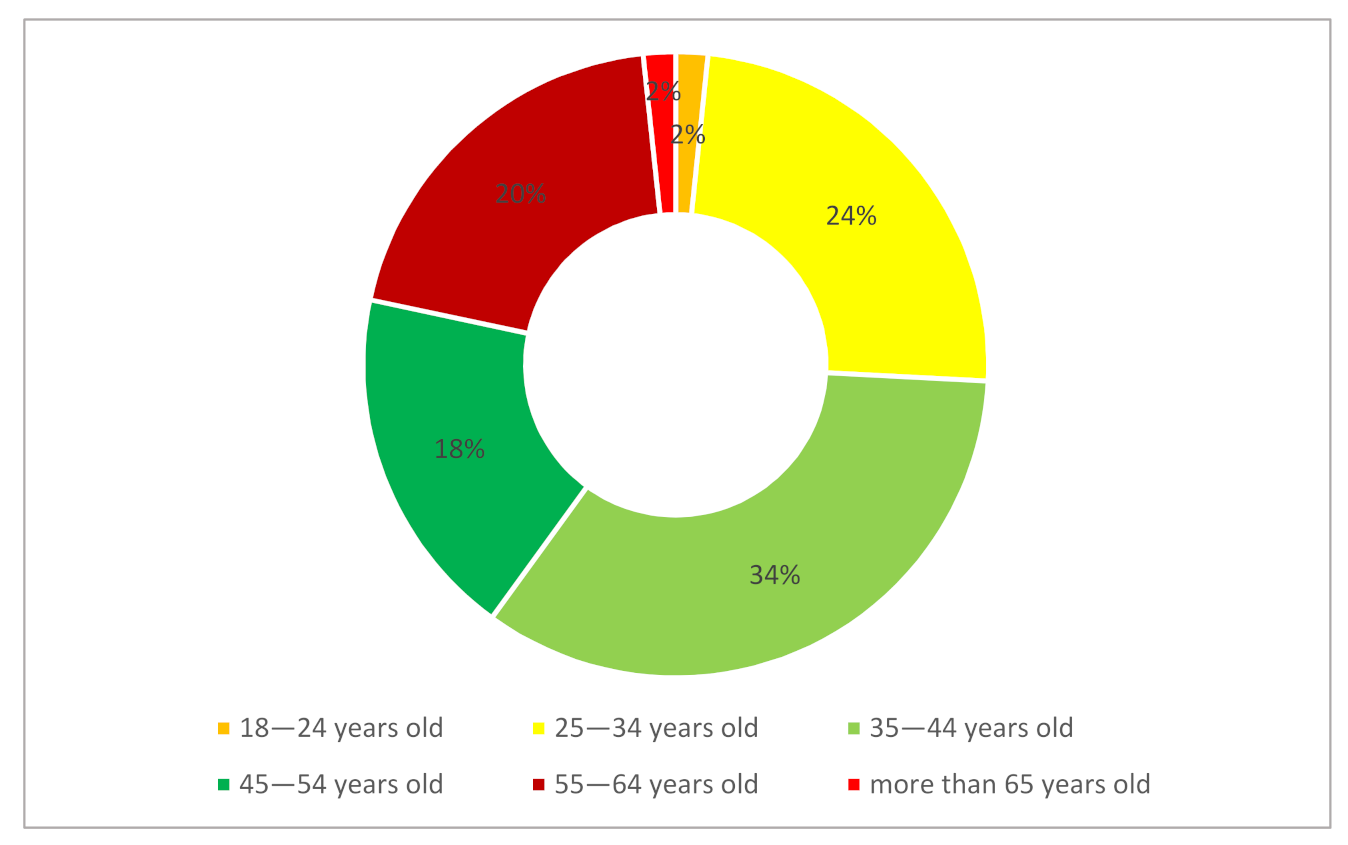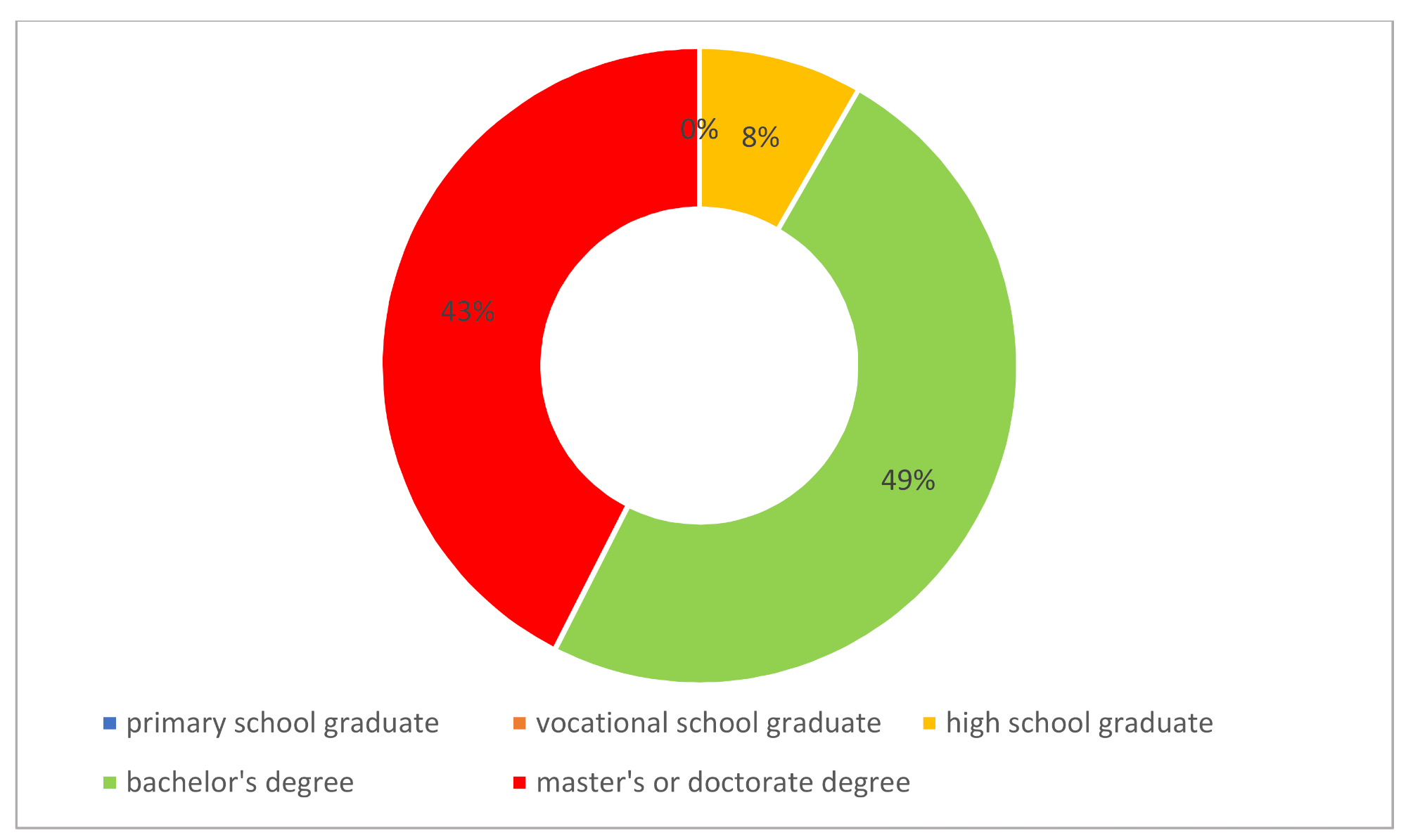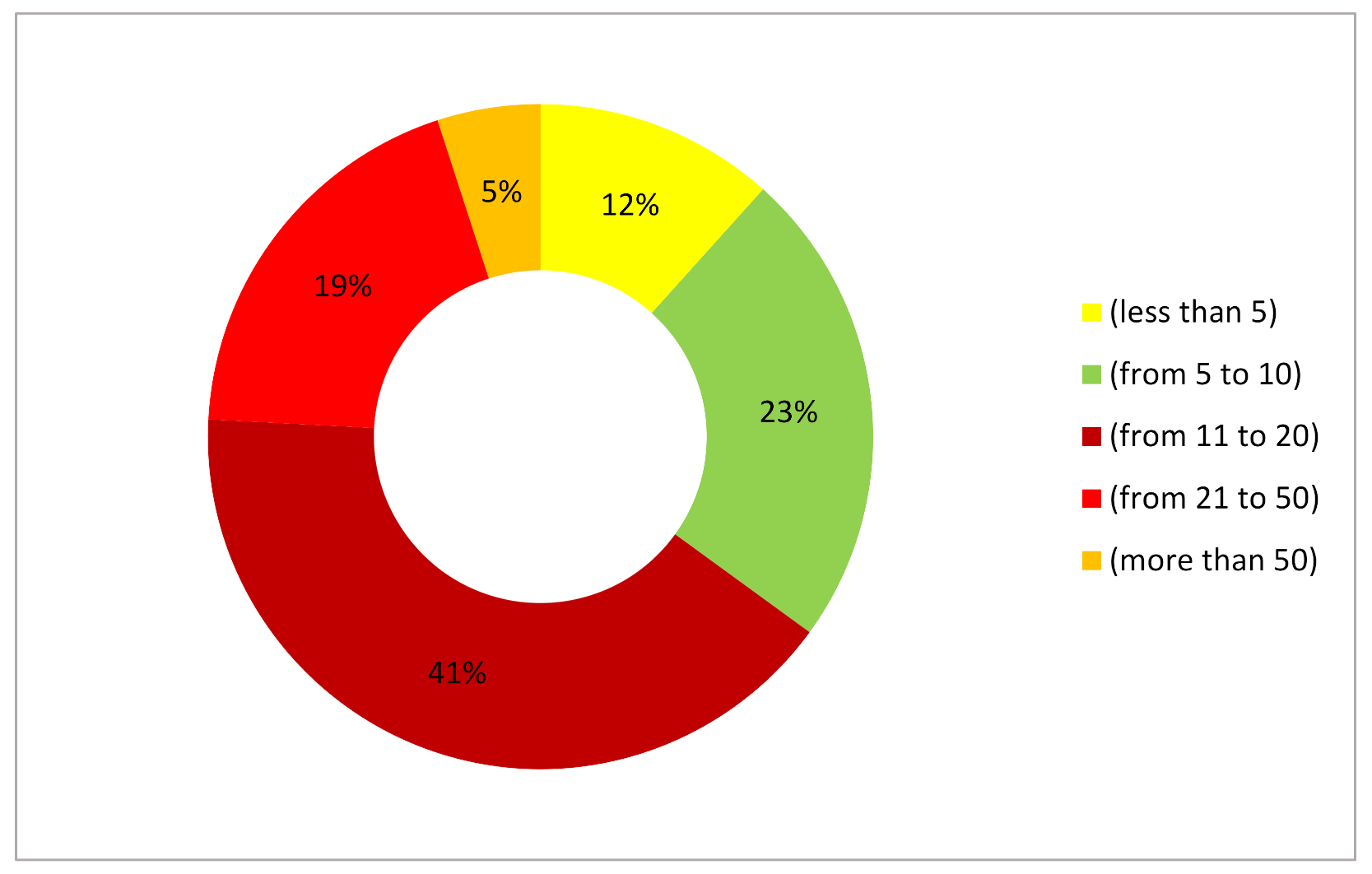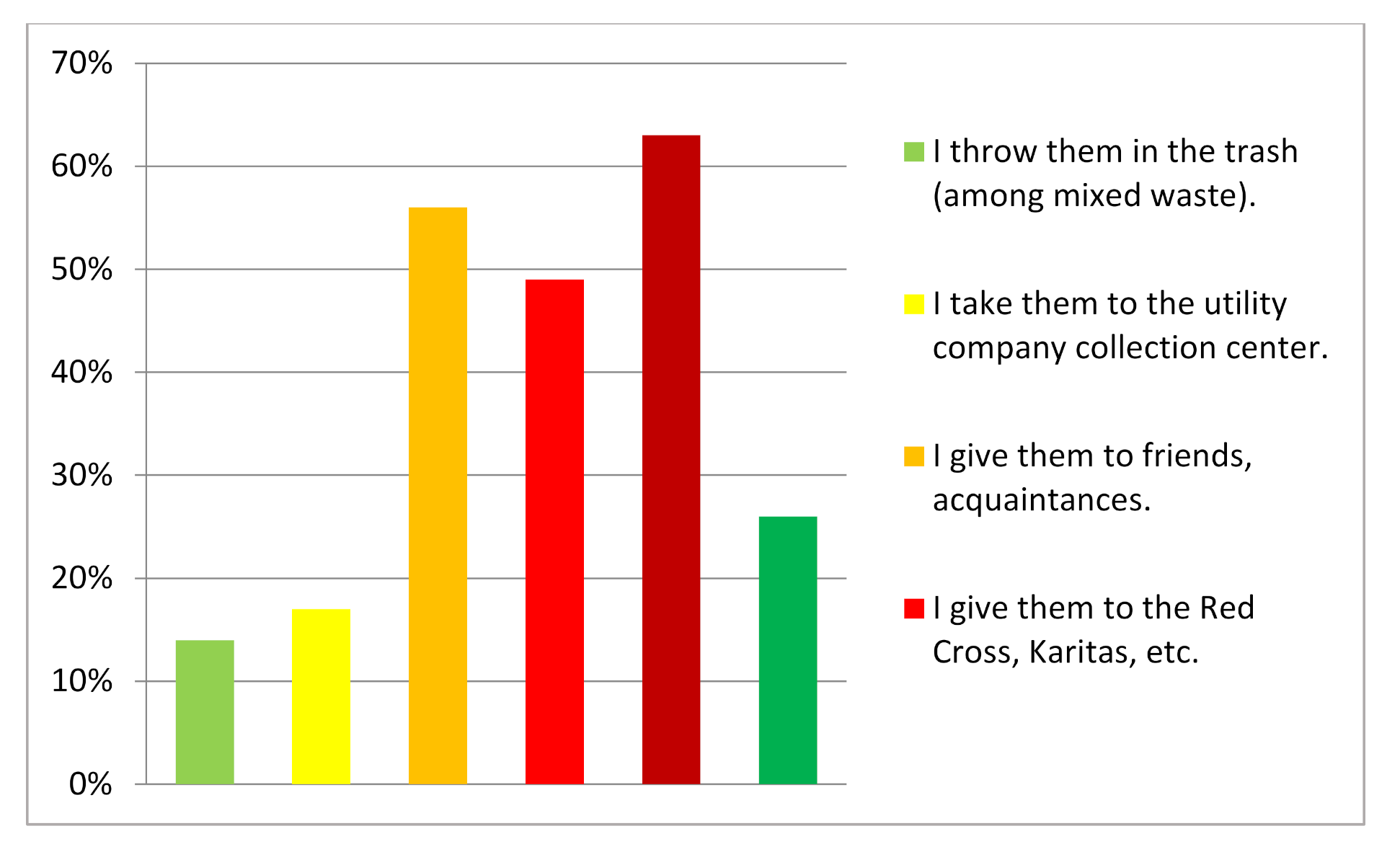Issues Surrounding Behavior towards Discarded Textiles and Garments in Ljubljana
Abstract
1. Introduction
Theoretical Background
2. Methods
3. Results
4. Discussion
5. Conclusions
Author Contributions
Funding
Informed Consent Statement
Data Availability Statement
Conflicts of Interest
References
- Podjed, D.; Polajnar Horvat, K. The invisible life of food waste: The case of Ljubljana households. Tradition 2020, 49, 109–124. [Google Scholar] [CrossRef]
- Waste Management. Available online: https://www.stat.si/statweb/File/DocSysFile/8272 (accessed on 14 April 2021).
- Kaza, S.; Yao, L.C.; Bhada-Tata, P.; van Woerden, F. What a Waste 2.0: A Global Snapshot of Solid Waste Management to 2050; Urban Development; World Bank Publications: Washington, DC, USA, 2018. [Google Scholar]
- Waste. Available online: https://www.stat.si/StatWeb/Field/Index/13/70 (accessed on 1 February 2021).
- Smrekar, A.; Valjavec, M.B.; Polajnar Horvat, K.; Tiran, J. The geography of urban environmental protection in Slovenia: The case of Ljubljana. Acta Geogr. Slov. 2019, 59, 8–80. [Google Scholar] [CrossRef]
- The Ecochic Design Award Sourcing Textile Waste. Available online: https://static1.squarespace.com/static/582d0d16440243165eb756db/t/585a15a9bebafba69927c172/1482298805626/LEARN2014_Sourcing_ENG-07.pdf (accessed on 24 May 2021).
- Private Consumption: Textiles EU’s Fourth Largest Cause of Environmental Pressures after Food, Housing, Transport. 2019. Available online: https://www.eea.europa.eu/highlights/private-consumption-textiles-eus-fourth-1 (accessed on 1 February 2021).
- What’s New in Clothing Recycling? 2020. Available online: https://www.livingcircular.veolia.com/en/industry/whats-new-in-clothing-recycling (accessed on 1 February 2021).
- A New Circular Economy Concept. 2018. Available online: http://www.resyntex.eu/images/downloads/RESYNTEX-Leaflet-2018.pdf (accessed on 1 February 2021).
- Textiles in Europe’s Circular Economy. 2019. Available online: https://www.eea.europa.eu/themes/waste/resource-efficiency/textiles-in-europe-s-circular-economy (accessed on 1 February 2021).
- Anguelov, N. The Dirty Side of the Garment Industry: Fast Fashion and Its Negative Impact on Environment and Society; Routledge: Boca Raton, FL, USA, 2016. [Google Scholar]
- Measuring Fashion. Environmental Impact of the Global Apparel and Footwear Industries Study. Available online: https://quantis-intl.com/wp-content/uploads/2018/03/measuringfashion_globalimpactstudy_full-report_quantis_cwf_2018a.pdf (accessed on 24 May 2021).
- Sandin, G.; Ross, S.; Spak, B.; Zamani, B.; Peters, G. Environmental Assessment of Swedish Clothing Consumption—Six Garments, Sustainable Futures; RISE Ab: Götheburg, Sweden, 2019. [Google Scholar]
- Beckert, S. Empire of Cotton: A Global History; Vintage Books: New York, NY, USA, 2014. [Google Scholar]
- Thomas, D. Fashionopolis the Price of Fast Fashion and the Future of Clothes; Head of Zeus: New York, NY, USA, 2019. [Google Scholar]
- Nencková, L.; Pecáková, I.; Šauer, P. Disposal behaviour of Czech consumers towards textile products. Waste Manag. 2020, 106, 71–76. [Google Scholar] [CrossRef] [PubMed]
- Östlund, A.; Roos, S.; Sweet, S.; Sjöström, E. Investor Brief: Sustainability in Textiles and Fashion; The Swedish Foundation for Strategic Environmental Research: Stockholm, Sweden, 2020. [Google Scholar]
- Nordås, H.K. The Global Textile and Clothing Industry Post the Agreement on Textiles and Clothing; World Trade Organization: Geneva, Switzerland, 2004; Available online: https://www.wto.org/english/res_e/booksp_e/discussion_papers5_e.pdf (accessed on 1 February 2021).
- Joy, A.; Sherry, F.J.; Venkatesh, A.; Wang, J.; Chan, R. Fast fashion, sustainability, and the ethical appeal of luxury brands. Fash. Theory 2012, 16. [Google Scholar] [CrossRef]
- Ghemawat, P.; Iniesta, J.L.N. ZARA: Fast Fashion; Harvard Business Publishing: Boston, MA, USA, 2003; Available online: https://hbsp.harvard.edu/product/703497-PDF-ENG?Ntt=Zara&itemFindingMethod=Search (accessed on 1 February 2021).
- Bhardwaj, V.; Fairhurst, A. Fast fashion: Response to changes in the fashion industry. Int. Rev. Retail Distrib. Consum. Res. 2010, 20. [Google Scholar] [CrossRef]
- McAfee, A.; Dessain, V.; Sjöman, A. Zara: IT for Fast Fashion; Harvard Business Publishing: Boston, MA, USA, 2004; Available online: https://store.hbr.org/product/zara-it-for-fast-fashion/604081 (accessed on 1 February 2021).
- Choi, T.; Liu, S.; Tsang, T.K.L.; Zheng, J. Service quality strategy for fast fashion: An empirical study in Hong Kong. In Fast Fashion Systems: Theories and Applications; Tsan-Ming, C., Ed.; CRC Press: Boca Raton, FL, USA, 2014; pp. 129–140. [Google Scholar]
- Remy, N.; Speelman, E.; Swartz, S. Style That’s Sustainable: A New Fast-Fashion Formula; McKinsley Sustainability: New York, NY, USA, 2016; Available online: https://www.mckinsey.com/business-functions/sustainability/our-insights/style-thats-sustainable-a-new-fast-fashion-formula# (accessed on 1 February 2021).
- Filho, W.L.; Ellams, D.; Han, S.; Tyler, D.; Boiten, V.; Paço, A.; Moora, H.; Balogun, A.-L. A review of the socio-economic advantages of textile recycling. J. Clean. Prod. 2019, 218. [Google Scholar] [CrossRef]
- Humana. Available online: https://www.humana.si/copy-of-r-osrednjeslovenska-regija (accessed on 1 February 2021).
- Nieboer, H. Kam Izginjajo Zabojniki za Zbiranje Oblačil? 2019. Available online: https://ebm.si/prispevki/kam-izginjajo-zabojniki-za-zbiranje-oblacil (accessed on 1 February 2021).
- Waste. 2021. Available online: https://www.vokasnaga.si/odpadki (accessed on 1 February 2021).
- European Parliament and Commission. Direktive (EU) 2018/851. 2018. Available online: http://data.europa.eu/eli/dir/2018/851/oj (accessed on 1 February 2021).
- Laitala, K. Consumers’ clothing disposal behaviour—A synthesis of research results. Int. J. Cons. Stud. 2014, 38. [Google Scholar] [CrossRef]
- Nørup, N.; Pihl, K.; Damgaard, A.; Scheutz, C. Quantity and quality of clothing and household textiles in the Danish household waste. Waste Manag. 2019, 87. [Google Scholar] [CrossRef] [PubMed]
- Zhang, L.; Wu, T.; Liu, S.; Jiang, S.; Wu, H.; Yang, J. Consumers’ clothing disposal behaviors in Nanjing, China. J. Clean. Prod. 2020, 276. [Google Scholar] [CrossRef]
- Sohn, J.; Nielsen, K.S.; Birkved, M.; Joanes, T.; Gwozdz, W. The environmental impacts of clothing: Evidence from United States and three European countries. Sustain. Prod. Consum. 2021. [Google Scholar] [CrossRef]
- Becker-Leifhold, C.; Heuer, M. Eco-Friendly and Fair: Fast Fashion and Consumer Behaviour; Routledge: Milton, UK, 2018. [Google Scholar]
- Rathinamoorthy, R. Sustainable Fashion: Consumer Awareness and Education; Muthu, S.S., Ed.; Springer: Berlin/Heidelberg, Germany, 2018. [Google Scholar]
- Hetherington, K. Secondhandedness: Consumption, disposal, and absent presence. Environ. Plan. D 2004, 22. [Google Scholar] [CrossRef]
- Bianchi, C.; Birtwistle, G. Consumer clothing disposal behaviour: A comparative study. Int. J. Consum. Stud. 2012, 36. [Google Scholar] [CrossRef]
- Miller, D. Home Possessions. Material Culture behind Closed Doors; Routledge: Milton, UK, 2001. [Google Scholar]
- Selan, A.T. Household Budget Survey and Household Spending Patterns in Slovenia and the European Union. Master’s Thesis, University of Ljubljana, Ljubljana, Slovenia, 2006. [Google Scholar]
- European Commission. Economic Accounts of the European Union; Panorama of the European Union; European Commission: Luxembourg, 1999. [Google Scholar]
- Vukadin, B.; Burja, A.; Kušar, U. Potrošnja v gospodinjstvih: Število in velikost gospodinjstev. In Kazalci Okolja v Sloveniji; Ministry of Environment: Ljubljana, Slovenia, 2011; Available online: http://kazalci.arso.gov.si/?data=indicator&ind_id=348 (accessed on 1 February 2021).
- Splošen Opis. 2021. Available online: https://www.1ka.si/d/sl/o-1ka/splosen-opis (accessed on 1 February 2021).
- Nieboer, H.; Sreš, K.; Zorko, B.; Kranjc, J. Obleka Naredi Človeka: Rezultati Vseslovenske Raziskave o (Odvrženih) Oblačilih; Zavod za Pravično Trgovino, 3MUHE: Ljubljana, Slovenia, 2021; Available online: http://www.oblekanaredicloveka.si/wp-content/uploads/2021/03/ONC-raziskava_small.pdf (accessed on 24 May 2021).
- Habinc, M. Izjemnost trgovanja z rabljenimi oblačili v (sodobni) Sloveniji? Gaz. Sloven. Ethno. Soc. 2016, 56, 321–343. [Google Scholar]
- Appelgren, S.; Bohlin, A. Introduction: Circulating stuff through second-hand, vintage and retro markets. J. Curr. Cult. Res. 2015, 7. [Google Scholar] [CrossRef]
- Gabrielli, V.; Baghi, I.; Codeluppi, V. Consumption practices of fast fashion products: A consumer-based approach. J. Fash. Mark. Manag. 2013, 17. [Google Scholar] [CrossRef]
- Bruce, M.; Daly, L. Buyer behavior for fast fashion. J. Fash. Mark. Manag. 2006, 10, 329–344. [Google Scholar]
- Žagar, J. Oblačilna Kultura Delavcev v Ljubljani Med Prvo in Drugo Svetovno Vojno; Mladika: Ljubljana, Slovenia, 1994. [Google Scholar]
- Makarovič, M. Obleka Predela Človeka: Oblačilna Kultura v Kmečkem Okolju na Severu in Jugovzhodu Štajerske od 18. do 20. Stoletja; Litera: Maribor, Slovenia, 2007. [Google Scholar]
- Joanes, T.; Gwozdz, W.; Klöckner, C. Reducing personal clothing consumption: A cross-cultural validation of the comprehensive action determination model. J. Environ. Psychol. 2020, 71, 1–10. [Google Scholar] [CrossRef]
- Manshoven, S.; Christis, M.; Vercalsteren, A.; Arnold, M.; Nicolau, M.; Lafond, E.; Mortensen, L.F.; Coscieme, L. Textiles and the Environment in a Circular Economy. Eionet Report. 2019. Available online: https://ecodesign-centres.org/wp-content/uploads/2020/03/ETC_report_textiles-and-the-enviroment-in-a-circular-economy.pdf (accessed on 31 May 2021).
- Polajnar Horvat, K. Environmentally Friendly Behavior; Georitem 26: Ljubljana, Slovenia, 2015. [Google Scholar]
- Polajnar Horvat, K. The efficacy of social influence in environmental awareness and behaviour regarding water. Geogr. Vestn. 2017, 89, 37–49. [Google Scholar] [CrossRef]
- Kovačič, G.; Grubar, V.B. Knowledge of sustainable development among geography students in Slovenia. Acta Geogr. Slov. 2016, 56. [Google Scholar] [CrossRef]




| Question | I Am Not Aware at All | I Am Not Aware | I Am Partly Aware | I Am Aware | I Am Very Aware | Total | (Mean) | Standard. Deviation |
|---|---|---|---|---|---|---|---|---|
| To what extent do you feel you are environmentally aware? | 0 | 0 | 11 | 79 | 30 | 120 | 4.20 | 0.57 |
| 0% | 0% | 9% | 66% | 25% | 100% | |||
| To what extent do you feel aware of textile waste? | 1 | 6 | 45 | 53 | 15 | 120 | 3.60 | 0.80 |
| 1% | 5% | 38% | 44% | 13% | 100% |
Publisher’s Note: MDPI stays neutral with regard to jurisdictional claims in published maps and institutional affiliations. |
© 2021 by the authors. Licensee MDPI, Basel, Switzerland. This article is an open access article distributed under the terms and conditions of the Creative Commons Attribution (CC BY) license (https://creativecommons.org/licenses/by/4.0/).
Share and Cite
Polajnar Horvat, K.; Šrimpf Vendramin, K. Issues Surrounding Behavior towards Discarded Textiles and Garments in Ljubljana. Sustainability 2021, 13, 6491. https://doi.org/10.3390/su13116491
Polajnar Horvat K, Šrimpf Vendramin K. Issues Surrounding Behavior towards Discarded Textiles and Garments in Ljubljana. Sustainability. 2021; 13(11):6491. https://doi.org/10.3390/su13116491
Chicago/Turabian StylePolajnar Horvat, Katarina, and Katarina Šrimpf Vendramin. 2021. "Issues Surrounding Behavior towards Discarded Textiles and Garments in Ljubljana" Sustainability 13, no. 11: 6491. https://doi.org/10.3390/su13116491
APA StylePolajnar Horvat, K., & Šrimpf Vendramin, K. (2021). Issues Surrounding Behavior towards Discarded Textiles and Garments in Ljubljana. Sustainability, 13(11), 6491. https://doi.org/10.3390/su13116491






